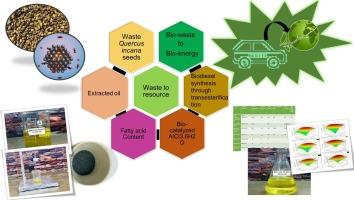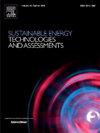Harnessing non-edible Quercus incana seeds for sustainable and clean biodiesel production using seed-derived green Al2O3 nanocatalyst
IF 7.1
2区 工程技术
Q1 ENERGY & FUELS
Sustainable Energy Technologies and Assessments
Pub Date : 2024-10-21
DOI:10.1016/j.seta.2024.104025
引用次数: 0
Abstract
The challenges of resource scarcity and waste deposition have increased raw material costs and imposed stricter waste management regulations. This study presents the first attempt to utilize high oil-yielding Quercus incana seeds (55.77 wt%, 0.28 % FFA) as a novel waste feedstock for synthesizing a bio-fabricated Al2O3 nanocatalyst and its application in producing high-quality biodiesel. A maximum biodiesel yield of 97.6 % was achieved under optimal conditions, including a 1:9 oil-to-methanol ratio, a 120-minute reaction time at 70 °C, and 0.25 % catalyst concentration. The formation of biodiesel was confirmed through various analytical techniques, such as 1H- and 13C NMR, FTIR, and GC–MS. Additionally, the physicochemical properties of the biodiesel, including sulfur content (0.00047 wt%), TAC (0.20 mg KOH/g), cloud point, and pour point (−11 °C), were analyzed and compared to international biodiesel standards to ensure its stability, sustainability, and eco-friendliness. The production of biodiesel from Quercus incana, a non-edible, uncultivated waste feedstock, supports a greener revolution and a net-zero carbon society. It also promotes smarter waste management practices globally.

利用源自种子的绿色 Al2O3 纳米催化剂,利用非食用柞树种子生产可持续的清洁生物柴油
资源稀缺和废物沉积带来的挑战增加了原材料成本,并实施了更严格的废物管理条例。本研究首次尝试利用高产油的柞树种子(55.77 wt%,0.28 % FFA)作为新型废弃物原料,合成生物制造的 Al2O3 纳米催化剂,并将其应用于生产高质量生物柴油。在最佳条件下,包括油甲醇比为 1:9、反应时间为 120 分钟、温度为 70 °C、催化剂浓度为 0.25 %,生物柴油的最高产量达到 97.6 %。生物柴油的形成通过各种分析技术(如 1H- 和 13C NMR、傅立叶变换红外光谱和气相色谱-质谱)得到了证实。此外,还分析了生物柴油的理化性质,包括硫含量(0.00047 wt%)、TAC(0.20 mg KOH/g)、浊点和倾点(-11 °C),并与国际生物柴油标准进行了比较,以确保其稳定性、可持续性和生态友好性。利用柞树(一种非食用、非耕种的废物原料)生产生物柴油,有助于实现绿色革命和净零碳社会。它还能在全球范围内推广更智能的废物管理方法。
本文章由计算机程序翻译,如有差异,请以英文原文为准。
求助全文
约1分钟内获得全文
求助全文
来源期刊

Sustainable Energy Technologies and Assessments
Energy-Renewable Energy, Sustainability and the Environment
CiteScore
12.70
自引率
12.50%
发文量
1091
期刊介绍:
Encouraging a transition to a sustainable energy future is imperative for our world. Technologies that enable this shift in various sectors like transportation, heating, and power systems are of utmost importance. Sustainable Energy Technologies and Assessments welcomes papers focusing on a range of aspects and levels of technological advancements in energy generation and utilization. The aim is to reduce the negative environmental impact associated with energy production and consumption, spanning from laboratory experiments to real-world applications in the commercial sector.
 求助内容:
求助内容: 应助结果提醒方式:
应助结果提醒方式:


